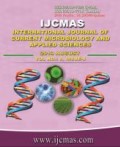


 National Academy of Agricultural Sciences (NAAS)
National Academy of Agricultural Sciences (NAAS)

|
PRINT ISSN : 2319-7692
Online ISSN : 2319-7706 Issues : 12 per year Publisher : Excellent Publishers Email : editorijcmas@gmail.com / submit@ijcmas.com Editor-in-chief: Dr.M.Prakash Index Copernicus ICV 2018: 95.39 NAAS RATING 2020: 5.38 |
The goat contributes 3.5 % of the total milk and 19% of the total meat production in India. As Goat is called a poor man's cow because it provides milk, manure and protein source at low cost. Goat is gaining recognition in the backyard industry because of fewer space necessities and better efficiency than cattle’s. Production performances supposed to vary with twin or singlet kidding in goats. The present investigation was undertaken to study the production performance in a singlet and twin kid bearing Surti goats. The milk yield in twin bearing goats was significantly (P<0.01) higher on 7 (528.57±31.99 Vs 314.28±58.84), 15 (714.28±40.40 Vs 414.28±50.84), 30 (500±92.58 Vs 314.28±40.40) day of kidding. Udder length (40.00±0.53 Vs 35.57±1.32) in doe was significantly higher (P<0.05) in twin bearing goats on 45 days of kidding. Other udder parameters were also higher in twin but it was not significant. The result shows the udder development and milk production higher in twin bearing doe hence value also related to parity.
 |
 |
 |
 |
 |